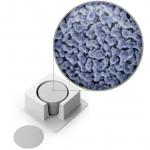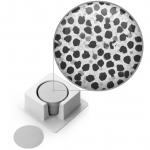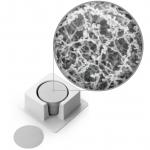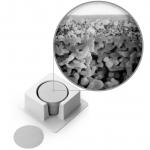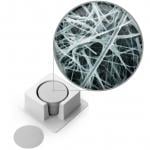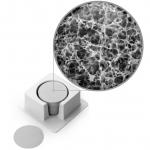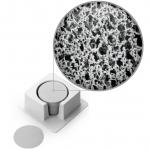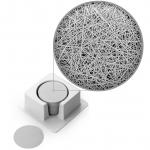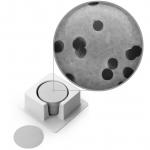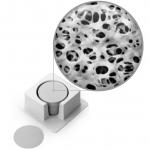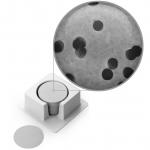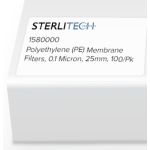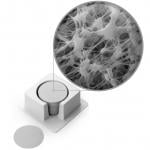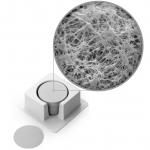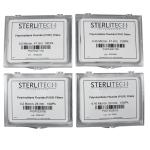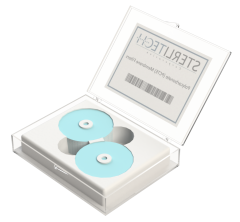Membrane Disc Filters
Sterlitech offers a comprehensive selection of polymeric and inorganic membrane filter materials, enabling users to perform everything from solvent filtration to gas venting. Please consult with our filtration experts for assistance in membrane selection, questions about our products available on a commercial scale, or try a customized sample pack to get started.
Our pre-cut membrane disc filters are produced using the highest quality manufacturing standards. These filters are designed to increase efficiency, reduce cost, and expand the capabilities of microfiltration applications.
Membrane disc filter accessories are available for added convenience. Additionally, we offer a wide variety of pressure filter holders and vacuum filter holders to suit most applications. Check out great deals on discounted and expired disc filters in our Clearance Section.
If you want to learn how you can test your membranes, checkout our Bubble Point Testing whitepaper here.
We provide the filters and technical support to help you take your breakthrough product from an idea to a prototype, to commercial scale.
 Frequently Asked Questions
Frequently Asked Questions
Q: What is the shelf life of the silver membrane filters?
A. There is no predetermined shelf life for the silver membrane. The filters should be stored sealed in the original packaging until needed. Over time, silver compounds may form on the surface of the membrane. Any resulting surface discoloration is essentially cosmetic and does not affect filter performance.
Q: What is the difference between hydrophilic and hydrophobic membrane filters?
The pores of microporous membrane filters act as small capillaries. When hydrophilic membranes come into contact with water, capillary action associated with surface tension forces causes the water to spontaneously enter and fill the pores. In this manner, the membranes are easily wetted and allow the bulk flow of water through the pores. Once wetted, hydrophilic membranes will not allow the bulk flow of air or other gasses, unless they are applied at pressures greater than the membrane’s bubble point.
Hydrophilic membrane filters are typically used with water and aqueous solutions. They can also be used with compatible non-aqueous fluids. Hydrophilic membrane filters are typically not used for air, gas or vent filtration since the filters would block flow if inadvertently wetted, by condensation for example.
When hydrophobic membranes come into contact with water, surface tension forces act to repel the water from the pores. Water will not enter the pores and the membranes will act as a barrier to water flow, unless the water is applied at pressures greater than the membrane’s water entry pressure. Low surface tension fluids, such as alcohols, can spontaneously enter and fill the pores of hydrophobic membranes. Once all the air in the pores is displaced, there are no longer any surface tension forces and water can easily enter the pores, displace the low surface tension fluid, and pass through the membrane. The membrane will then allow bulk flow of water for as long as the pore remain water filled. If the membrane is allowed to dry (i.e. air enters the pores), then it must be pre-wet with a low surface tension fluid again prior to use with water.
Hydrophobic membrane filters are typically used with compatible non-aqueous fluids. They are also commonly used as air, gas, or vent filters. Hydrophobic membrane filters are sometimes used with water or aqueous solutions; and, in these applications, they must first be prewet with a low surface tension, water miscible fluid prior to use.
Q: Is your Cellullose Acetate (CA) membrane made of mono-, di-, or triacetate?
Sterlitech Cellulose Acetate (CA) membranes are made from cellulose diacetate. These membrane filters also have an integral nonwoven polyester (polyethylene terephthalate) support layer. When evaluating application compatibility, both materials should be considered.
Q: Can silver membrane filters be cleaned?
Q. Can silver metal membranes be cleaned?
A. Sterlitech™ Silver Membranes: Cleaning Guidelines
Sterlitech’s Silver Metal Membrane Filters can be cleaned and reused repeatedly. The membranes should be cleaned immediately after each use, and handled carefully to avoid membrane punctures and tears. Various cleaning procedures can be used, depending on the nature, type, and degree of contamination. There are four effective cleaning methods outlined below, that can be used to clean Sterlitech’s silver metal membrane filters.
Chemical Cleaning
Immerse in a strong alkaline solution, a solvent, or an acid. Do not immerse in nitric acid, sulfuric acid, or cyanide solutions.
Ignition Cleaning
Place the silver metal membrane filter in a laboratory muffle furnace for approximately ½ hour to effectively remove organic contaminants from the membrane. Do not exceed the following temperatures.
| Retention Rating (microns) | Maximum Temperature | |
| °C | °F | |
| 5.0 | 550 | 1020 |
| 3.0 | 400 | 750 |
| 1.2 | 350 | 660 |
| 0.8 | 300 | 570 |
| 0.45 | 300 | 570 |
| 0.2 | 250 | 480 |
Combination Cleaning
A combination of chemical and ignition cleaning may be the best method to completely regenerate the membrane. Immerse in a 10 percent concentration of hydrofluoric acid for ten minutes, followed by ignition cleaning in a muffle furnace, following the guidelines given above. This can allow for reuse of membrane up to 10 times.
Ultrasonic Cleaning
Low intensity ultrasonics can be used to clean the silver metal membrane. The cleaning intensity and time will depend on the degree and type of contamination encountered. Do not use high intensity ultrasonics.
Q: What are the advantages of Silver membrane filters?
Q. What are the advantages of silver metal membranes over conventional membranes?
A. Sterlitech™ Silver Metal Membranes are 99.97% pure, thus unique in their ability to withstand extreme chemical and thermal stress, making them ideal for applications involving aggressive fluids and/or high temperatures. In addition, the purity of the membranes enables users to easily exclude and account for the few chemicals that react with silver, thus making test results and filtering operations more precise than available through traditional membranes.
Q: What are the advantages of Sterlitech polycarbonate and polyester membrane filters?
Q. What are the benefits of using Sterlitech Polycarbonate or Polyester filter membranes?
A. Sterlitech Polycarbonate Track Etch (PCTE) and Polyester Track Etch (PETE) filters offer the lowest, non-specific binding of any filter membrane. The capture of samples occurs on a flat, glass-like smooth surface with an even distribution of particles captured on a single plane, simplifying microscopic and SEM examination of samples captured on the surface of the membrane.
- Sterlitech Track Etch filter membranes are manufactured and produced under class 100 condition during critical manufacturing steps. Therefore, the membrane is free of contaminants and pyrogens.
- Sterlitech PCTE and PETE membranes offer very low extractables. Both PCTE and PETE membranes are integral, plastic films, therefore, there is no sloughing or particle shedding.
- Sterlitech PCTE and PETE membranes are biologically inert.
- Both filter membranes offer excellent chemical resistance and thermal stability, with PETE offering a higher chemical resistance.
Q: Do Sterlitech PCTE membrane filters have any type of wetting agent on them?
Polycarbonate track-etch (PCTE) membranes are inherently
hydrophobic. The hydrophobic PCTE
membrane filters shown at https://www.sterlitech.com/hydrophobic-polycarbonate-membrane-filters.html do not have any wetting agents. Before use in water or aqueous solutions, these filters are usually pre-wet with a compatible low surface tension, water miscible fluid such as a low molecular weight alcohol.
The hydrophilic PCTE membrane filters shown at https://www.sterlitech.com/hydrophilic-polycarbonate-membrane-filters.html are treated with a wetting agent to render the membrane hydrophilic. The wetting agent consists of a few molecular
thicknesses of polyvinylpyrrolidone (PVP) deposited on the membrane
surfaces. The hydrophilic PCTE membrane filters can be used in water or aqueous solutions without pre-wetting.
Q: Do cells adhere to the surface of the Sterlitech track etch membranes?
Depending on the cell line, most exfoliated human cells adhere with some tenacity. Most epithelial cells will adhere if the membrane has a negative charge applied by gas plasma or has a suitable attractant applied to the surface of the membrane. Endothelial cells will generally not attach to the surface of Track Etch membranes.
Q: What is the difference between the shiny side and the dull side of the polycarbonate track-etch (PCTE) membrane filters?
There is a visually apparent difference between the sides of some of the PCTE membrane filters. This is a result of the process used to manufacture the polycarbonate base film. One side of the film has a very smooth surface resulting in a shiny appearance. The other side has an inherent surface texture resulting in a dull or matte appearance. The difference is purely physical; both sides are chemically the same. Filter orientation does not affect particle retention. For applications involving microscopic analyses of captured particles or microbes, most users prefer to orient the disk filter so that the smooth shiny side is facing upstream.
Q: What are the advantages of Ceramic membrane filters?
Ceramic membranes are composed of a matrix of zirconium oxide and titanium dioxide. These rigid, inert inorganic filters have superior chemical and thermal resistance. They can be operated at temperatures that would destroy conventional polymer membranes, up to 350°C. These attributes are uniquely suited to applications where the filters are subjected to repeated regeneration with chemical and high temperature cleanings.
Q: What are the advantages of MCE Membranes?
MCE membranes feature fast flow rates, a high protein binding capacity, and great thermal stability, making them a staple for many environmental and biological laboratories. Furthermore, they are available as presterilized, individually wrapped membranes, and can include a gridded pattern for quantifying microbial growth.
Q: What are the advantages of Nylon membrane filters?
Nylon Membranes exhibit high protein binding, solvent resistance, and dimensional stability due to support by inert polyester.
Q: What are the advantages of PAN membrane filters?
PAN Membranes combine excellent selectivity, high flow rates and low pressure requirements for use.
Q: What are the advantages of glass fiber filters?
Glass Fiber Filters are exhibit high operating temperatures and are particularly economical for use as a pre-filter.
Q: What are the advantages of PEEK membrane filters?
PEEK Membranes exhibit outstanding resistance to almost any known organic solvent, as they consist of pure PEEK (no sulfonation or similar).
Q: What are the advantages of polypropylene (PP) membrane filters?
PP Membranes exhibit good hydrophobicity and can be considered in applications that don't require the chemical compatability of PTFE.
Q: What is the thickness of polypropylene (PP) membrane filters?
You can find the current specifications for the Polypropylene (PP) membrane filters at https://www.sterlitech.com/polypropylene-membrane-filters.html. Click the "Application/Specification" tab near the middle of the page and scroll down as necessary.
Q: What are the advantages of PTFE membrane filters?
PTFE Membranes are extremely hydrophobic and exhibit superior chemical compatability with agressive solutions.
Q: How do I dispose of the static eliminator?
The small static eliminators offered at https://www.sterlitech.com/static-eliminator.html, in compliance with NRC regulations, may be disposed of in normal trash.
Q: Are tweezers required for handling membrane filters?
The membrane filter tweezers offered at https://www.sterlitech.com/stainless-steel-membrane-filter-tweezers-pad-tip-ends.html are recommended for handling membrane filters to minimize the potential for contamination and damage. However, the tweezers are not mandatory and most membrane filters can be installed by hand. Gloves are recommended when handling membrane filters to avoid contamination with skin oils.
Q: Can I purchase a smaller pack of the Cytoclear Slides?
Smaller pack sizes may be available for purchase. Please contact us at [email protected] to inquire about availability and pricing.
Q: Why is removal of static charge benefiical when working with Track Etched Membranes?
The polyester track-etch (PETE) membrane filters and polycarbonate track-etch (PCTE) membrane filters are among the thinnest membrane filters that we offer. They are more susceptible to accumulating electrostatic charges which can make them difficult to manipulate and position. The static eliminators offered at https://www.sterlitech.com/static-eliminator.html can be used to mitigate handling problems associated with electrostatic repulsion and static cling.
Q: What are the advantages of PCTE Membranes?
See existing
Q: What are the advantages of PES membrane filters?
PES Membranes are low protein binding, PES membrane filters are ideal for tissue culture media sterilization, life science and microbiology fluid applications.
Q: What are the advantages of Aluminum Oxide membrane filters?
Aluminum oxide is free of organic extractables and leachables and shows minimum adsorption.
Q: What solvents can I use to dissolve PCTE or PETE membrane filters?
The polycarbonate track-etch (PCTE) membrane filters can be dissolved with dipolar aprotic solvents such as dimethylformamide (DMF), dimethyl sulfoxide (DMSO) and n-methyl-2-pyrrolidone (NMP). The PCTE membrane filters can also be dissolved with the organic chlorinated solvents dichloromethane (DCM or methylene chloride) and trichloromethane (TCM or chloroform). PCTE membrane filters can also be dissolved with toluene and potentially with other similar aromatic hydrocarbon solvents.
The polyester track-etch (PETE) membrane filters can be dissolved with m-Cresol, o-Chlorophenol, hexafluoroisopropanol, and trifluoroacetic acid (TFA).
Both types of track-etch membranes can be dissolved with elevated temperature sodium hydroxide solutions.
Q: Are the aluminum oxide membrane disk filters available in diameters not listed in the ordering information?
Unfortunately, we are unable to supply the aluminum oxide membrane filters with custom diameters. Please contact us at [email protected] to inquire about alternatives.
Q: What are the differences between cellulose acetate (CA), nitrocellulose (NC), Mixed Cellulose Esters (MCE) and regenerated cellulose (RC) membrane filters?
Cellulose acetate (CA) membranes are made of entirely cellulose acetate polymer. These membrane filters have the lowest protein binding of the filer types in question and typically have the greatest throughput when used with proteinaceous solutions. They are also used in applications where maximum protein recovery is critical. The Sterlitech CA membranes have an integral nonwoven polyester support layer for improved strength and handling ease.
Ideally, nitrocellulose (NC) membranes would be made entirely of nitrocellulose polymer. However, almost all commercially available filtration grade membrane filters labeled as “nitrocellulose” are actually composed of membranes made with a mixture of nitrocellulose and cellulose acetate polymers. This is because pure nitrocellulose membrane filters are very difficult to manufacture with accpetable characteristics. In an effort to provide clarity to consumers, some manufactures refer to membranes containing a mixture of nitrocellulose and cellulose acetate polymers as mixed cellulose esters (MCE) membranes. In almost all applications, commercial nitrocellulose (NC) membrane filters and mixed cellulose esters (MCE) membrane filters are equivalent.
Mixed cellulose esters (MCE) membrane filters do not have a discrete support layer and are somewhat fragile and more difficult to handle
when compared to CA membrane filters. MCE membranes exhibit greater protein binding than CA membranes. However, MCE membranes tend to have more uniform pore structure and intrinsically greater clean water flow. MCE membrane filters have very good biocompatibility and are commonly used for microbiological studies. MCE filters are also traditionally used for silt density index (SDI) measurments.
Regenerated cellulose (RC) membranes are made by chemically treating nitrocellulose membranes so that the material reverts back to natural
cellulose. RC filters have the very good solvent resistance of traditional filter papers but with the much finer retention characteristics of polymer membrane filters. Additionally, regenerated cellulose is inherently hydrophilic and RC filters do not contain the wetting agents required by MCE and CA membrane filters.
Q: What grade of nylon is used to manufacture the Sterlitech nylon membrane filters?
The Sterlitech nylon membrane filters are constructed of nylon 66 polymer. Nylon 66 in inherently hydrophilic, nontoxic, and has good resistance to organic solvents. These membrane filters also have an integral nonwoven polyester (polyethylene terephthalate) support layer. When evaluating application compatibility, both materials should be considered.
Q: Can the polyacrylonitrile (PAN) membrane filters be used for drinking water?
Q: Are the polyether ether ketone (PEEK) membrane filters hydrophilic or hydrophobic?
The polyether ether ketone (PEEK) membrane filters are hydrophobic. However, they tend to have lower water entry pressures than other common hydrophobic membrane filters such as PTFE, polypropylene, and polyvinylidene difluoride (PVDF).
Q: What kind of polyester is used to make your polyester track etch (PETE) membranes?
The Sterlitech polyester track-etch (PETE) membranes are made of polyethylene terephthalate.
Q: Will Sterlitech polyester tract-etch (PETE) or polycarbonate track-etch (PCTE) membrane filters keep liquid behind the filter while allowing gases pass through?
Hydrophobic membrane filters are necessary for applications where the membrane is used to retain liquid water while allowing gases to pass through. Hydrophobic PCTE membranes typically have insufficient water entry pressures for these applications and will allow liquid water to pass at pressures lower than required. Hydrophobic PTFE and PETE membrane filters have the highest water entry pressures for membrane filters and are commonly used for these applications.
Q: Do you have a method for coating the PVP-Free polycarbonate track-etch (PCTE) membrane filters for Chemotaxis studies?
Membranes are used in the study of white blood cell reactions to toxins (chemotaxis), to determine the natural immunity in whole blood. Since immunity is transferable, this could lead to the development of vaccines for treatment of cancer and other diseases. Membranes may be polycarbonate, with or without polyvinylpyrrolidone (PVP). It depends on the type of cells used. Apparently, Neutrophils have a tendency to round up and fall off the membrane when around PVP - not so with some of the other types of cells. Refer to each procedure. Characteristics of PCTE Membrane and Advantages in Chemotaxis Studies Uniform Properties yield reliable, consistent, and reproducible results. Less cell distortion for improved morphology.
Zero leaching of offensive surfactants yields reliable, consistent, and reproducible results.
Smooth, flat surface contributes to high cell visibility on proximal and distal surfaces. Improved morphologic resolution. Easy removal of excess cells from proximal surface.
Thinness of the membrane allows shorter incubation time. More assays made faster and simpler. Chamber sterilization not needed for most studies. Facilitates study of slower moving cells (e.g., monocytes and macrophages).
Low adsorption and absorption of cells causes higher yields. Enhanced radiometric analysis.
Non-staining results in improved contrast. Simplifies optical microscopic analysis routine.
Transparency simplifies optical microscopic analysis routine.
Heat sealable characteristics aids in experimenting with disposable chambers.
Strength of membrane means that less critical handling techniques needed.
Coating Membranes with Gelatin Wash membrane with 0.5% Acetic Acid.
Make a stock gelatin solution with 50mg/10mL water.
Working solution is 1-mL stock to 1-liter water for a light coating.
Then the membranes are placed in a rolling boil of this solution in a beaker for 1 hour.
The membranes are individually pulled out and placed on filter paper to air dry. If an oven is used, use very low temperature for 20 minutes. Air-drying is best in a covered dish left over night. Keep clean.
When the membranes are dry, place them back in their original box.
NOTE: For Chemotaxis, the most important issue is to keep everything at 37 degrees C., the water bath, buffers, glassware, etc. for 1 hour. Studies in cold produce cells that "round up", curl up and fall off.
Q: Does Sterlitech offer ceramic membrane filters rated for reverse osmosis?
The ceramic membrane filters are only available with microfiltration and ultrafiltration retention characteristics. It is not within the capability of current technology to manufacture ceramic membranes with the salt rejection characteristics required for NF and RO applications.
Q: Do glass fiber filters shed?
To some extent, all glass fiber filters have the potential to shed some fibers. Acrylic resin bonded glass fiber filters typically shed much lower amounts of fibers compared to binderless glass fiber filters. The amounts of shed fibers not only depend on the grades of glass fiber media used but are also influenced by the application conditions. Shed fibers are not typically a concern in applications where the glass fiber filters are used as a prefilters for subsequent membrane filters.
Q: What is the proper orientation of the polyethersulfone (PES) membrane filters?
The polyethersulfone (PES) membrane filters have asymmetrical pore structure. The pore structure varies within the thickness of the membrane such that the largest openings occur on one side and the smallest openings occur on the opposite side. When viewing the membrane with reflected light at low incidence angles, each side has a somewhat different visual appearance. The side with the largest pores will appear more dull or matte than the side with the smallest pores. With a little bit of experience, most users can easily identify the sides. For optimal throughput, the PES membrane filters should be oriented so that side with the largest pores (the duller side) is facing upstream. For applications involving microscopic analyses of captured particles or microbes, the user may choose to orient the filter so that the side with the smallest pores (the shinier side) is facing upstream. This orientation may reduce throughput but it improves the likelihood of capturing particles of interest on the surface of the membrane instead of within the pore structure.
Q: Can I measure the pore size of polyester track-etch (PETE) membrane filters with a SEM?
It is possible to estimate the pore diameter of polyester track-etch (PETE) membranes from SEM images. In fact, this is how the pore size is characterized during manufacturing for most of the track-etch membranes. However, it is important to understand that there are calibration and performance variations between different SEMs. There is a good likelihood that a user’s results will not correlate to the manufacturing results that were used to characterize the membrane.
Q: What methods can be used to sterilize the polypropylene (PP) membrane filters?
Sterlitech polypropylene (PP) membrane filters maybe sterilized using compatible chemical agents such as ethylene oxide (EtO) or formalin.
Q: What is the difference between nominal and absolute pore size ratings?
Q. What is the difference between nominal and absolute pore size ratings?
Nominal pore size ratings are provided as a general indication of filter retention. It is understood that some quantity of particles greater than, and equal to, the nominal pore size ratings will pass through the filters into the filtrate. Some manufactures may associate nominal pore size ratings with percentage filtration efficiencies. Nominal pore size ratings vary from manufacturer to manufacturer and, consequently, are not necessarily equivalent. Filters from different manufactures with similar nominal pore size ratings may not actually exhibit similar retention characteristics.
Absolute pore size ratings are typically based on retention studies performed using challenge suspensions of standard microorganism cultures or particles of known size. Absolute pore size ratings represent the size of the smallest microorganisms or particles completely retained during these studies. Absolute pore size ratings are almost always correlated to bubble point specifications that are used for quality control during membrane manufacturing. For the most part, absolute pore size ratings, especially those based on microbial retention, are comparable from manufacturer to manufacturer. There is more uncertainty for absolute pore size ratings based on particle retention studies, especially for pore size ratings <0.2µm, since there are no standard methods for these studies.
Regardless of pore size ratings, it is important to understand that application conditions do influence particle retention. Even filters with absolute pore size ratings can be operated in conditions that will allow unexpectedly sized particles to pass.
Q: What is the amount of Lignin, if any, in the Cellulose Acetate membranes?
Not including the polyester support layer, the Cellulose Acetate (CA) membrane filters are composed entirely of cellulose acetate polymer. There may, however, still be a small amount of residual lignin present.
Q: Are the aluminum oxide membrane filters available with a perimeter support ring?
The Sterlitech aluminum oxide membrane filters are not available with perimeter support rings. However, when handled with care, they are suitable alternatives to competitive aluminum oxide membrane filters with ring supports.
Q: What type of holder is suggested for use with the ceramic membrane disk filters?
The ceramic membrane disk filters are considerably thicker than conventional membrane disk filters and will not fit in conventional disk filter holders. The ceramic membrane disk
filters must be used with the specially designed holders offered here.
Q: Does Sterlitech offer mixed cellulose esters (MCE) membrane disk filters with custom diameters?
Unfortunately, in most instances, we are unable to supply the MCE membrane filters with custom diameters. Please inquire with your Sterlitech sales representative about alternatives.
Q: What is the function of the binder in the glass fiber filters?
The acrylic (PMA) resin binder significantly improves the wet strength of the glass fiber filters. Resin bonded glass fiber filters are easier to handle and are resistant to fiber shedding. When evaluating application compatibility, it is important to consider the acrylic (PMA) resin.
Q: Are the polyethersulfone (PES) membranes asymmetric or symmetric?
The polyethersulfone (PES) membranes used in the Sterlitech membrane filters have asymmetric pore structure. The pore structure varies within the thickness of the membrane such that the largest openings occur on one side and the smallest openings occur on the opposite side. When viewing the membrane with reflected light at low incidence angles, each side has a somewhat different visual appearance. The side with the largest pores will appear more dull (or matte) than the side with the smallest pores
(which will appear shinier). With a little bit of experience, most users can easily identify the sides. The membranes can be used with either surface oriented upstream without affecting retention. However, orienting the dull side upstream increases total throughput
while orienting the shiny side upstream allows for better analyses of the retained particles.
Q: What is the contact angle angle of polypropylene (PP) membrane filters?
The polypropylene membrane is hydrophobic and typically has a water contact angle of about 100deg or more.
Q: What is the difference between pore size and porosity?
The pore size refers to the diameter of the individual pores in a membrane filter. Pore size is typically specified in micrometers (µm). Most membranes and filter media actually contain a distribution of pore sizes. Nominal pore size ratings typically refer to the predominant pore size of a filtration media; pores larger and smaller than the nominal rating may be present. Absolute pore size ratings typically refer to the largest pore size of a membrane and it is expected that all pores will be equal to or smaller than the absolute rating.
For the polycarbonate track-etch (PCTE) and polyester track-etch (PETE) membrane filters, porosity is the percent of the total surface area occupied by the pores; it typically ranges from <1% to 16%. For the other membrane filters, porosity is the percent of the total volume occupied by the pores; it typically ranges from 40 to 80%.
Q: What can be used to dissolve the aluminum oxide membrane filters?
The aluminum oxide membrane filters can be readily dissolved with sodium hydroxide solutions at 1M concentration or higher. The time required to dissolve the membrane can be reduced by elevating the temperature and/or increasing the concentration.
Q: What are the advantages of Cellulose Acetate (CA) membrane filters?
Cellulose acetate (CA) membrane filters are one of the lowest protein binding filters available. They will generally have greater throughput with proteinaceous solutions when compared to other membrane filters. CA membrane filters are ideal for filtration of protein and enzyme solutions, tissue culture media and serums, biological fluids, and similar applications where maximum recovery of protein is critical.
CA membranes are manufactured with an integral nonwoven polyester support layer resulting in a dimensionally stable strong membrane that is easier to handle and resistant to curling. The filters have superior resistance to tearing and can withstand steam sterilization up to 135°C. They are suitable for use at elevated temperatures.
CA membranes are hydrophilic and readily wet in water and aqueous solutions. They have good chemical resistance and can be used with low molecular weight alcohols.
Q: Are Sterlitech ceramic membrane disk filters available with diameters other than 47mm and 90mm?
The ceramic membrane filters are only available with 47mm and 90mm diameters. You may want to consider other inorganic membranes, such as alumina oxide or silver, for applications requiring different diameters.
Q: Why are non-sterile MCE Membrane filters more expensive than presterilized MCE membranes filters?
Sterile mixed cellulose esters (MCE) membrane filters are used in vast quantities for microbiological studies across many industries and are manufactured in very high volumes to accommodate this demand. Economies of scale and process automation allow the sterile MCE membrane filters to be offered at lower pack costs compared to non-sterile MCE membrane filters. Non-sterile MCE filters are used much less frequently, necessitating less efficient, smaller volume manufacturing runs and packaging methods. Consequently, the non-sterile MCE membrane filters have intrinsically greater manufacturing costs and must be offered at higher prices.
Q: I noticed that the listed equivalent glass fiber filters have different specifications. What is the reason for this?
Glass Fiber Filters have nominal pore size ratings. These ratings are not necessarily consistent between different manufacturers. Consequently, it is possible for glass fiber filters from different manufacturers to have equivalent retention characteristics while having different nominal pore size ratings.
Q: Can polyethersulfone (PES) membrane filters be used for lateral flow applications?
For lateral flow assays, membranes with high protein binding capacities are preferred. Consequently, with their inherently low protein binding capacities, PES membrane filters are typically not used in these applications.
Q: How do I determine if my filter is compatible with my application?
You can find the Sterlitech compatibility guide. It is important to realize that application conditions, such as operating temperature, affect compatibility. Please contact us at [email protected] if you need assistance.
Q: Can the aluminum oxide membrane filters be used as alternatives for the Whatman Anodisc filters?
Yes, the Sterlitech aluminum oxide membrane filters can be used as alternatives for the Whatman Anodisc filters. Our alumina filters do not have perimeter support rings, so somewhat greater care must be taken when handling the filters to avoid damage.
Q: How can I convert from a pore size rating in microns to molecular weight cutoff (MWCO) in Daltons?
There is no direct conversion between microns, a unit of length, and Daltons, a unit of molecular weight. However, there is an approximate correlation between pore size rating and MWCO. However, the following chart can be consulted to know what MWCO might fit best based on the pore structure of the membranes.
Q: What are the dimensions for the grid printed on the presterilized mixed cellulose esters (MCE) membrane 47 mm disk filters?
The grid dimensions are 3mm x 3mm. The average number of squares for a 47 mm disc filter is 185.
Q: What is a bubble point and how is it determined?
The bubble point is the minimum amount of pressure required to push air bubbles through the largest pore of a wet membrane. The bubble point is inversely proportional to the pore diameter, as the pore diameter decreases the bubble point increases and vice versa.
Retention efficiency of membrane filters can be directly measured by challenging the filters with suspensions of standard microorganism cultures or particles of known size. Unfortunately, such efficiency testing is necessarily destructive. However, since retention characteristics are dependent on pore size, it is possible to correlate destructive challenge testing results to non-destructive membrane bubble point tests. In this manner, the relationship between membrane pore size and membrane bubble point is empirically determined. Typically, a minimum bubble point can be determined and specified for a particular pore size rating. The bubble point specification is then used for quality control during membrane manufacture. The bubble point can also be used by the consumer as a nondestructive test to verify membrane integrity before and/or after use.
Q: What is the difference between a depth filter and membrane filter?
Depth filters are constructed with relatively thick filtration media and typically have nominal pore size ratings >1µm. Due to their large void volume, they capture significant amounts of particulate within their pore structure.
Membrane filters are typically composed of polymers that have been chemically processed, resulting in highly porous thin films with microscopic pore structures. Membrane filters typically have absolute pore size ratings <1µm, with some exceptions. Because of their very fine pore structure, membrane filters tend to trap the majority of particles on the surface. However, smaller particles with diameters near or below the pore size rating can be captured within the membrane or pass through the membrane.
Q: What's the benefit of purchasing sample packs?
Sample packs allow the customer to purchase small quantities of membrane filters at nominal cost, with various diameters and pore sizes as selected. This allows the customer to preform trials as needed to determine the optimal filter for their application before committing to purchasing standard pack quantities.
Q: The membrane material I'd like to test is not listed with the sample packs. Can I still get a sample?
We may be able to offer some additional membrane options that are not listed. Please contact us at [email protected] to inquiry about availability and pricing.
Q: Are membrane filter samples available in diameters others than 13, 25, or 47mm?
In most cases, membrane filter samples can be purchased in sizes that are not listed in the standard sample packs. Please contact us at [email protected] to inquire about availability and pricing.
Q: How can I tell the difference between the separator papers and the membrane filters?
To ensure ease of use, the membrane filters as stacked in their packaging are interleafed with layers of separator paper. In most cases, the membrane filters will be white in color except for the track-etch membranes which are colorless and translucent. In some special cases, the membranes will be dyed dark grey to black in appearance. In all cases, the separator paper will be a different color than the membrane and is usually not white. Please contact us at [email protected] if you need assistance.


